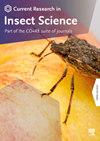热效应对 diapausing Pieris rapae 蝴蝶新陈代谢率的影响
IF 2.7
Q1 ENTOMOLOGY
引用次数: 0
摘要
作为变温动物,许多昆虫在冬季处于假死状态(即滞育),降低它们的代谢率以维持有限的能量储备。滞育期间降低代谢率的能力部分依赖于寒冷的冬季温度,以内在地降低代谢率。与全球气候变化相关的冬季变暖可能会增加昆虫的代谢率,从而对滞育昆虫构成挑战,可能导致能量储备枯竭。我们用停止流动呼吸法测量了滞育的菜青虫蛹在急性和慢性冬季变暖情景下的耗氧量。滞育蛹的代谢率随温度的升高而升高,但与蛹龄和升温程度有关,蛹龄越大,总体代谢率越低。尽管代谢率增加,但短期急性增温暴露后,蛹在24小时内恢复代谢率。相比之下,在数周或数月的时间里,长期暴露在变暖环境中会导致滞育后期代谢率显著下降,蛹质量也会减少。这些结果表明,虽然呼吸是热响应的,但变暖不会导致代谢率的持续增加。相反,滞育的油菜似乎通过降低代谢率来适应数月的慢性变暖,从而适应更高的温度。总的来说,这些模式表明,至少在能量学的背景下,这个物种可以适应冬季变暖。然而,这些反应背后的确切机制仍有待研究。因此,未来的研究——例如:在变暖背景下能量学的遗传基础上,可以进一步阐明滞育昆虫对未来冬季变暖的相对脆弱性。本文章由计算机程序翻译,如有差异,请以英文原文为准。
Thermal effects on metabolic rate in diapausing Pieris rapae butterflies
As ectotherms, many insects spend the winter months in a state of suspended animation (i.e., diapause), lowering their metabolic rates to subsist on a limited store of energy reserves. The ability to lower metabolic rate during diapause relies, in part, on cold winter temperatures to intrinsically lower metabolic rate. Winter warming associated with global climate change may pose a challenge to diapausing insects by intrinsically increasing metabolic rate, potentially leading to the exhaustion of energetic reserves. We used stop-flow respirometry to measure oxygen consumption in response to temperatures representative of both acute and chronic winter warming scenarios in diapausing Pieris rapae pupae. Metabolic rate increased with increasing temperature in diapausing pupae, but metabolic rate depended on both pupal age and warming severity, with older pupae having lower metabolic rates overall. Despite the increases in metabolic rate, pupae recovered metabolic rate within 24-hours after short-term acute-warming exposure. In contrast, chronic exposure to warming over weeks and months led to significant decreases in metabolic rate later in diapause, as well as reductions in pupal mass. These results demonstrate that while respiration was thermally responsive, warming did not lead to sustained increases in metabolic rate. Instead, diapausing P. rapae appear to acclimate to higher temperature by lowering their metabolic rates in response to months of chronic warming. Overall, these patterns suggest that this species could be resilient to winter warming, at least in the context of energetics. However, the precise mechanisms underlying these responses remain to be characterized. Thus, future research—e.g., on the genetic underpinnings of energetics in the context of warming—could further elucidate the relative vulnerability of diapausing insects to future winter warming.
求助全文
通过发布文献求助,成功后即可免费获取论文全文。
去求助
来源期刊

Current Research in Insect Science
Agricultural and Biological Sciences-Animal Science and Zoology
CiteScore
3.20
自引率
0.00%
发文量
22
审稿时长
36 days
 求助内容:
求助内容: 应助结果提醒方式:
应助结果提醒方式:


